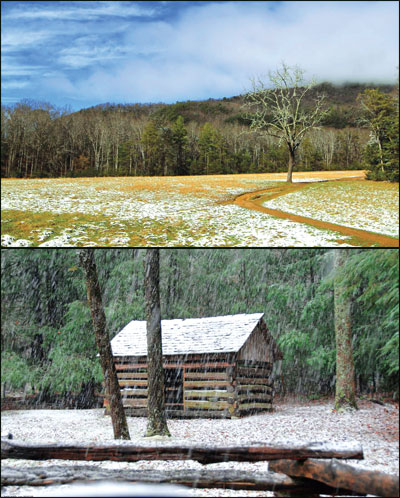|
The Smoky Mountains:
A wondrous diversity of life
Ridge upon ridge of forest straddles the border between North
Carolina and Tennessee in Great Smoky Mountains National Park. World
renowned for its diversity of plant and animal life, the beauty of its
ancient mountains, and the quality of its remnants of Southern
Appalachian mountain culture, this is America’s most visited national
park.
 Cades Cove is an eleven mile, scenic loop road on the valley floor in
the TN Smokey Mountains, and it only took about 30 minutes drive there
from the town. The drive captures the scenery in its full glory.As you
head closer to the mountains, there is obviously some elevation gain,
and there iss an increasing amount of fallen snow around, especially
once you got into the cove itself. It all looks beautiful. Cades Cove is an eleven mile, scenic loop road on the valley floor in
the TN Smokey Mountains, and it only took about 30 minutes drive there
from the town. The drive captures the scenery in its full glory.As you
head closer to the mountains, there is obviously some elevation gain,
and there iss an increasing amount of fallen snow around, especially
once you got into the cove itself. It all looks beautiful.
The cove is now on the National Register of Historic Places, and is
well-known for its amazing mountain views. Before the Smokey Mountains
National Park was formed, however, it was home to many early European
settlers, and in addition to its wildlife and scenic views, it is still
home to some very well-preserved settlers’ homesteads.Way out in the
distance at the end of the path you can see John Oliver’s Cabin –the
first cabin in the Smokies, set up by two European immigrants who were
the first settlers to this part of the mountains.
There’s also Elijah Oliver Place – son of John! Seems he was one of
those charitable kind of folk that aren’t so commonplace nowadays – he
had a “strangers room” built on his front porch. Basically a hospitality
room for fisherman who’d come to the cove and be in need of lodging.
There were various other historical structures throughout the cove,
including a couple of churches. The Primitive Baptist Church – and
incidentally, the Oliver family is buried in the cemetery behind it.
There is a lot of interesting history to be had in Cades Cove.
The surrounding scenery is so breathtaking that it just draws you out
there.The loop road is a one way, single track road with a low speed
limit. Apparently it can take as much as four hours to get around in the
height of tourist season. A truly breathtaking location.
Biological diversity is the hallmark of the Great Smoky Mountains
National Park, which encompasses over 800 square miles in the Southern
Appalachian Mountains. No other area of equal size in a temperate
climate can match the park’s amazing diversity of plants, animals, and
invertebrates.
Over 17,000 species have been documented in the park: Scientists
believe an additional 30,000-80,000 species may live here. Why such a
wondrous diversity? Mountains, glaciers, and weather are the big
reasons. The park is the largest federally protected upland landmass
east of the Mississippi River. Dominated by plant-covered, gently
contoured mountains, the crest of the Great Smokies forms the boundary
between Tennessee and North Carolina, bisecting the park from northeast
to southwest in an unbroken chain that rises more than 5,000 feet for
over 36 miles. Elevations in the park range from 875 to 6,643 feet.

This range in altitude mimics the latitudinal changes you would
experience driving north or south across the eastern United States, say
from Georgia to Maine. Plants and animals common in the southern United
States thrive in the lowlands of the Smokies while species common in the
northern states find suitable habitat at the higher elevations.
The Great Smoky Mountains are among the oldest mountains in the
world, formed perhaps 200-300 million years ago.
They are unique in their northeast to southwest orientation, which
allowed species to migrate along their slopes during climatic changes
such as the last ice age,10,000 years ago. In fact, the glaciers of the
last ice age affected the Smoky Mountains without invading them. During
that time, glaciers scoured much of North America but did not quite
reach as far south as the Smokies. Consequently, these mountains became
a refuge for many species of plants and animals that were disrupted from
their northern homes.
The Smokies have been relatively undisturbed by glaciers or ocean
inundation for over a million years, allowing species eons to diversify.
In terms of weather, the park’s abundant rainfall and high summertime
humidity provide excellent growing conditions. In the Smokies, the
average annual rainfall varies from approximately 55 inches in the
valleys to over 85 inches on some peaks - more than anywhere else in the
country except the Pacific Northwest. During wet years, over eight feet
of rain falls in the high country.
The relative humidity in the park during the growing season is about
twice that of the Rocky Mountain region.Some 100 species of native trees
find homes in the Smokies, more than in any other North American
national park.
Almost 95% of the park is forested, and about 25% of that area is
old-growth forest - one of the largest blocks of deciduous, temperate,
old-growth forest remaining in North America. Over 1,500 additional
flowering plant species have been identified in the park.
The park is the centre of diversity for lungless salamanders and is
home to more than 200 species of birds, 66 types of mammals, 67 native
fish species, 39 varieties of reptiles, and 43 species of amphibians.
Molluscs, millipedes, and mushrooms reach record diversity here.
In recognition of the park’s unique natural resources, the United
Nations has designated Great Smoky Mountains National Park as an
International Biosphere Reserve.
-Internet |

